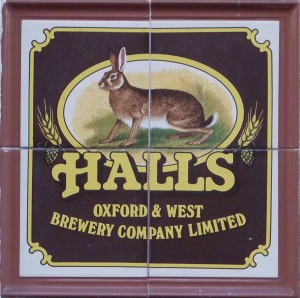On September 14th Liz Woolley gave a talk to us on “Beer, Sausages and Marmalade – 19th Century Food in Oxford”. She began by mentioning the main providers of food and drink supplies – namely Brewers, Butchers, Corn Dealers and Bakers, Grocers and Provision Merchants.
Brewing had taken place in Oxford from Medieval times, but the demand for beer and other food items increased substantially in the 19th Century as the population grew and tourism created more demand. There were four main brewing families – the Tawneys, the Halls, the
Treachers and the Morrells. They were all related by marriage and were men of wealth and influence in the city. Hanleys, who operated from Pembroke Street on the site of the present Modern Art building, were later taken over by Halls. Their water was supplied by four wells on the premises and their offices were in Queen Street, on the site of the BHS store. The Pembroke
Street building was designed by the architect H G W Drinkwater who carried out a number of other commissions for Breweries and industrial buildings in Oxford.
In addition to the breweries there were two associated malthouses. Edward Tawney owned Fox’s Malthouse and in 1790 he built 1 Fisher Row and also a large property next door as an almshouse for 6 men and 6 women. Philanthropy seemed to go hand in hand with many of the influential businesses in the city. Edward Tawney also ran the brewery in St Thomas Street, which later became Morrells Lion Brewery. Fortunately the redevelopment of the site
allowed for the Brewery chimney and water wheel to remain. In addition to the main breweries there were many smaller operations including colleges and the Radcliffe Infirmary. We were told that patients were allowed a ration of 1½ pints per day!
In 1883 there were 319 outlets for alcohol to serve a population of 42,000. Butchery was another important provider of food, and in the 19th century the Cattle Market was a very important feature of city life. It was situated in what is now Gloucester Green, and was supplied from a wide area. Farmers brought their cattle by road or rail. One feature of this trade was the
appearance of the Oxford Sausage, which was a very spicy blend of pork, veal, lemon, herbs and spices, not encased in the normal sausage skin. A Poet Laureate actually called a collection of poems “The Oxford Sausage”. It quite quickly became famous, thanks to clever publicity that referred to the ‘celebrated’ Oxford Sausage, and claimed Royal connections (because
students related to the Royal Family bought them).
The Covered Market was another very important feature of Oxford life. It was supplied and run by local farmers. It was described as “the biggest market under one roof in England”. An important figure there was William H Alden, who had a farm off the Abingdon Road. His stall is still operating in the Covered Market in the 21st century. William Alden’s son, Leonard ran it until 1937, when he died in a road accident.
Another important activity in Oxford was the sale of Corn, hence the Cornmarket, and the Corn Exchange in George Street. One of the most famous, and notorious, was Isaac Grubb, a non-conformist corn merchant and baker. Unfortunately he became very unpopular among the population because he was suspected of selling bread at cheaper prices to the University Colleges than to the people at large. This led to riots in the city centre, which became so bad that the Army (Guards from Windsor) were called out. Eventually things quietened down, and the price of bread was lowered.This was followed by the appearance of Bakeries that had a tea room attached. One of the most popular of these was Boffins, in the High Street near the Carfax.
In the 19th Century food, especially groceries, began to be sold as packaged food, and this became very popular. Shops specialising in this became very successful. One of these was Underhills, that started life in the High Street, then branched into the Cornmarket, and St Clements in the ‘suburbs’. The Owner, Charles Underhill, became Mayor of Oxford in 1887, and his son, Sydney, was also elected Mayor.
Another establishment, Grimbly Hughes, was also very successful, lasting well into the 20th Century. James Hughes was Mayor of Oxford 6 times. The invention of Oxford Marmalade was credited to Sarah Cooper. In 1902 Frank Cooper moved the family business to the factory building opposite the Station in what is now Frideswide Square. The well-known façade is still
there, but without the famous sign advertising Oxford Marmalade. The product became celebrated both in this country and abroad. Frank Cooper created a tourist book on Oxford which contained many pages on Marmalade. Famously, Scott took large quantities of Cooper’s Marmalade to the South Pole and Kim Philby was also supplied by the KGB on his defection to the Soviet Union. However, not everyone was a fan. One customer wrote that she was ‘very disappointed’ with the product, and suggested ways in which it might be improved.

